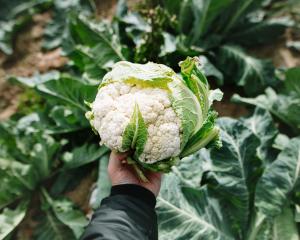Vegetables
Hedges can protect vegetable crops from wind damage but, because they need regular clipping, busy gardeners and those with small patches may prefer to use windcloth, manuka scrub or similar.
The ideal shelter hedge is no more than 1.5m tall. Keep its base compact by clipping plants hard from the earliest stages of growth and keep soil around them free of weeds.
Lonicera nitida, an evergreen honeysuckle sometimes sold as box, is suitable as a close-growing shelter hedge with small-leaved, dense growth. Propagate from cuttings taken in autumn and winter. Growing best on moderate to heavy soils, it has a root system which does not travel far into neighbouring plots.
Golden akeake or akiraho (Olearia paniculata) and Escallonia (the pink-flowered form is best) are other hedge plants suitable for the vegetable garden. They can be grown from cuttings, but a headstart will be achieved if plants two or three years old are used.
Broad beans and globe or Jerusalem artichokes will give temporary shelter to protect tender crops from strong early-summer winds.
Jerusalem artichokes, shallots and garlic are among the few crops that can be planted in the open ground at this time of year. Provided the soil is not frozen or waterlogged, these hardy plants do best when planted now, coming away quickly in early spring.
Rhubarb plants that have been in the same site for several years can be broken up with a sharp spade. Replant pieces in heavily manured, deeply dug soil.
Keep autumn-sown onion seedlings free from weeds by lightly hoeing around the rows. The old practice was to apply soot to stimulate the young plants, but this is not now recommended.
Flowers
Even the smallest section should have some space for a shrub or two, perhaps an azalea or rhododendron, a camellia, lilac or an evergreen native shrub. Identifying a site’s soil condition will help determine what will grow best. Transforming hard clay or a rocky, dry slope into an area of fertile, friable soil is hard work but there are attractive shrubs that will grow in poor soils. There are plants to withstand salt-laden winds and others that will grow in locations where high trees, steep slopes or tall buildings limit direct sunlight.
Avoid digging holes for shrubs in the middle of an uncultivated area. Circles of cultivated ground surrounded by firm soil collect rainwater. Dig over a larger site to surround the spot where the shrub is to grow, covering the soil later with groundcover plants or wood chips.
Add compost, well-rotted stable manure, leaf mould or rotted straw to the soil. Let this settle for a few days or weeks before planting the shrub. Always consider how wide and tall the shrub will grow.
Shrubs suitable for seaside gardens include rosemary, ngaio (Myoporum laetum) and lilac.
For lime-free soils, try rhododendrons, azaleas, Kalmia, daphne, Erica, camellias, Pieris, magnolia, Gaultheria and hydrangeas. For heavy, clay soils, Deutzia, firethorn (Pyracantha), Spiraea and Weigela are useful, while Tamarix and the spindle tree (Euonymus) are strong
enough for windswept gardens.
Rock rose (Cistus), rosemary and many South African and Australian shrubs are suitable for dry, stony soils, and for shade or beneath trees, rhododendrons, Cistus and Viburnum are options.
Fruit
Blueberries are one of the most antioxidant-rich fruits and their popularity is increasing worldwide.
The blueberry is native to the eastern United States and the fruit has been eaten by native Americans for centuries, but it was not until the early 20th century that work was undertaken on developing large-fruited hybrids. In New Zealand, efforts started in about 1979 to breed new cultivars with an eye to developing an export market. Blue Magic and Tasty Blue are among the New Zealand-bred varieties.
There are three main types of blueberries: highbush, rabbiteye (the most heat-tolerant) and southern highbush.













